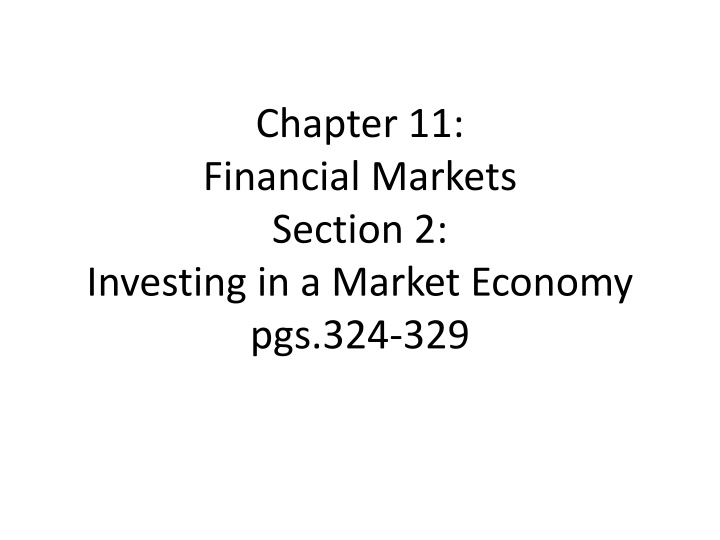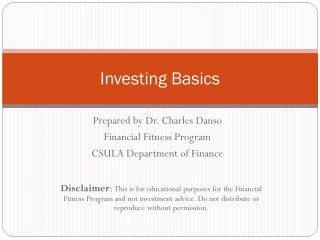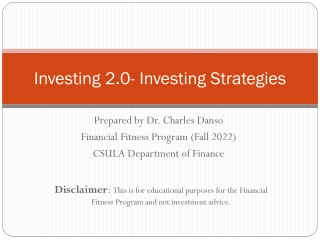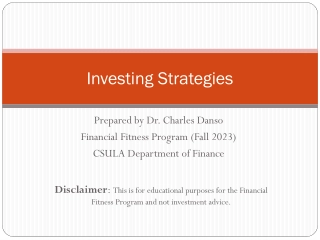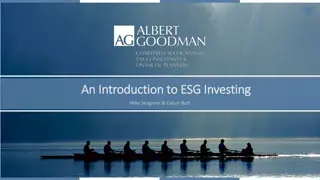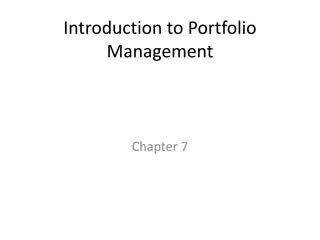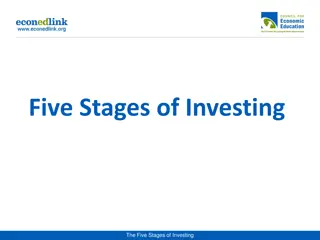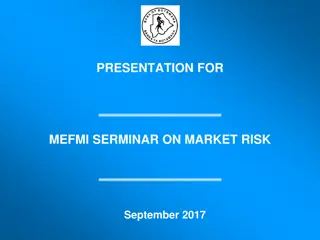Investing in a Market Economy: Objectives, Goals, and Risk
Importance of setting clear investment objectives and goals, such as saving for retirement, a house, or college tuition. Learn about factors like time, income, and risk management in making informed investment decisions. Discover the concept of diversification in balancing risk and return for a successful investment portfolio.
Download Presentation

Please find below an Image/Link to download the presentation.
The content on the website is provided AS IS for your information and personal use only. It may not be sold, licensed, or shared on other websites without obtaining consent from the author.If you encounter any issues during the download, it is possible that the publisher has removed the file from their server.
You are allowed to download the files provided on this website for personal or commercial use, subject to the condition that they are used lawfully. All files are the property of their respective owners.
The content on the website is provided AS IS for your information and personal use only. It may not be sold, licensed, or shared on other websites without obtaining consent from the author.
E N D
Presentation Transcript
Chapter 11: Financial Markets Section 2: Investing in a Market Economy pgs.324-329
Why Are You Investing? http://www.pinoyinvestor.com/wp-content/uploads/2014/01/investment-objective1.jpg There are two types of investing: personal & economic. This chapter uses the word invest as a quick way to refer to personal investing which is, in effect, saving. There is a number of assets you can own, but how do you determine which is, or are, right for you? You must decide why you are investing, this is your investment objective, or a financial goal that an investor uses to determine if an investment is appropriate.
Goals https://lift-user-uploads.s3.amazonaws.com/groups/76/width_440_piggybank-1024x682.jpg 1. Saving money for retirement 2. Down payment on a house 3. Down payment on an automobile 4. College tuition 5. Vacation Your goal helps you to determine the right investments.
Investment Objectives http://www.cimb-principal.com/images/articles/malaysia/img_investment_goals.jpg Two issues play a major role in determining which investment objectives. The 1stis Time. For example, is this a short-term financial goal such as saving for a vacation, or a long-term financial goal, such as saving for retirement? The 2ndis income. Example: how much money do you have available to save after meeting current expenses?
More Questions http://earlyretirementahead.com/wp-content/uploads/2015/05/creditcards.jpg Will your income change in the future? Is there money available for emergencies? You should have three months bills saved in case of emergencies. Do you have any outstanding debts? Paying off debts is an important first step to investing. Generally, the interest you pay on debts, such as credit cards, is higher than what you earn through investments. Are you paying taxes on time? Tax considerations are most important for investors with higher incomes who are subject to higher tax rates.
Risk and Return http://stofferwealthadvisors.com/wp-content/uploads/2014/12/Risk-and-Return.jpg Once investors have decided their financial objectives, there are two other related issues they might consider risk and return. Risk is the possibility for loss on an investment, and return is the profit or loss made on an investment.
Diversification Most investments carry some possibility of losing part of the money invested. Return may refer to the interest paid on a savings account or CD or the increase in value of stock over time. Most investors try to balance risk and return through diversification, the practice of distributing investments among different financial assets to maximize return and limit risk. http://neutrongroup.cachefly.net/missions/diversification/basket.jpg
What Kind of Risk Are You Willing to Take? http://images.slideplayer.com/21/6260154/slides/slide_1.jpg Savings deposits, CDs, bonds that are backed by the U.S. government are all almost risk- free. A big risk that investors face, is the loss of purchasing power of money invested due to inflation. That is why many financial advisers warn against investing everything in safe investments that pay a guaranteed rate of interest that may not keep up with inflation. Other investments, such as stocks & corporate bonds, carry a higher degree of risk b/c the return depends on how profitable the company is.
What Kind of Return Do You Want? http://thumbs.dreamstime.com/z/risk-reward-28072868.jpg Risk and return are directly related the greater the possible return, the higher the risk that the investment will lose value. People who are investing for retirement over a period of 20 to 30 years may be willing to take more risk. People with less time and less income to invest might not be willing to risk possible losses. Diversification is the most common way for investors to maximize their returns and limit their risk.
